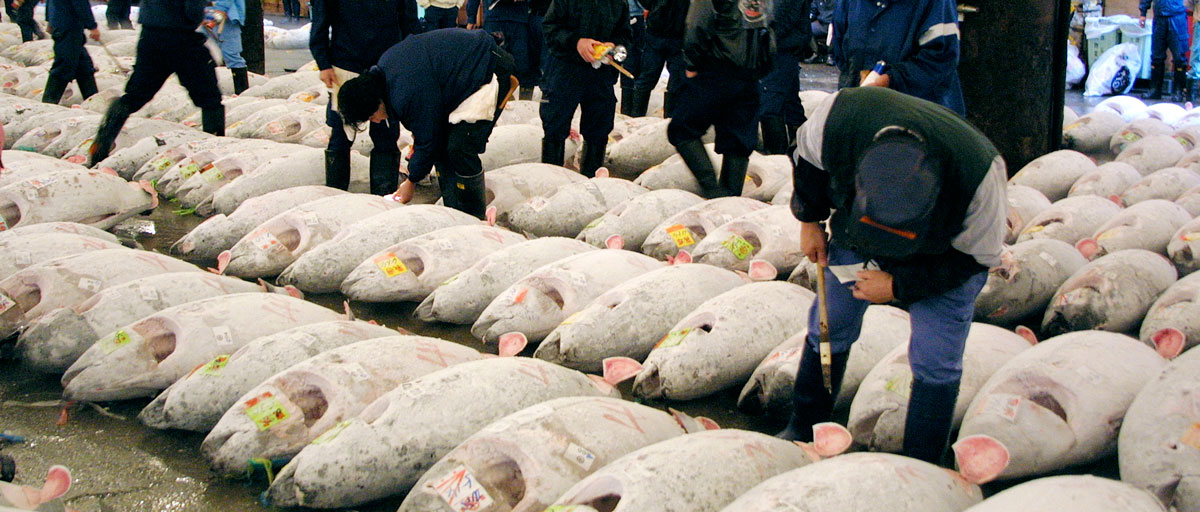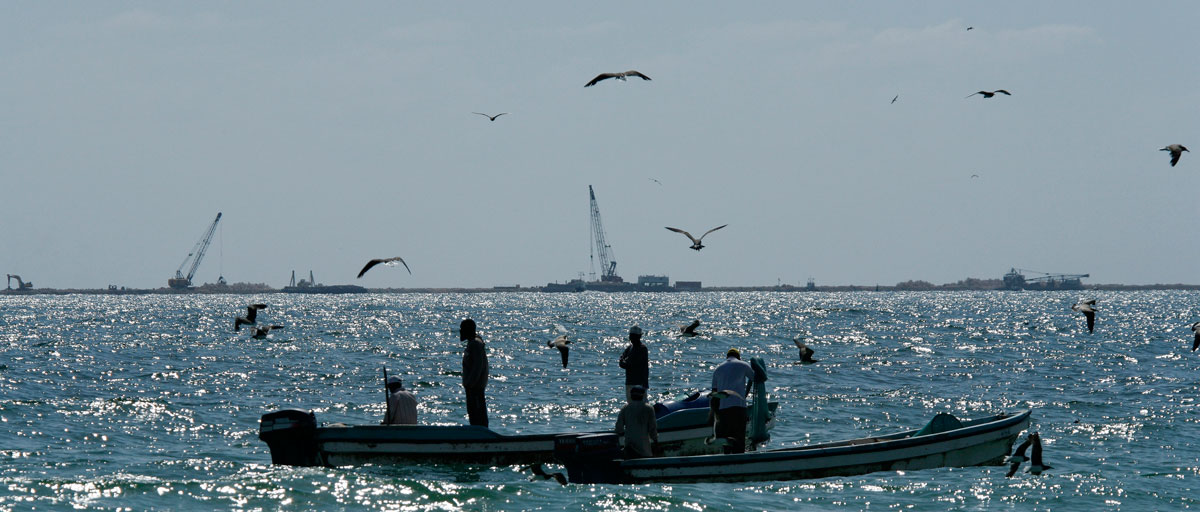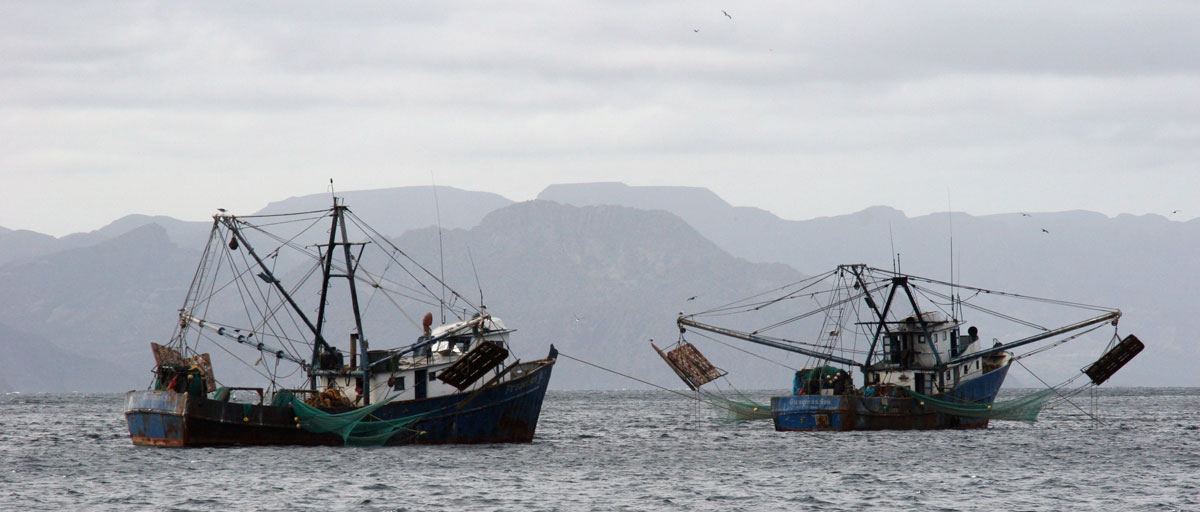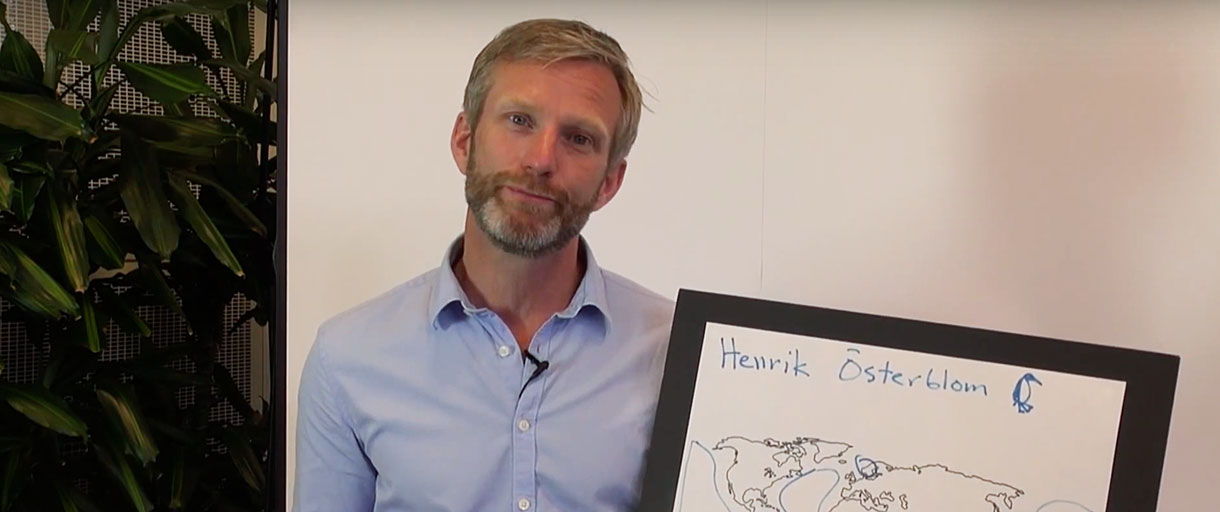
Henrik Österblom explains his research
meet our researchers
A dialogue for the ocean
Henrik Österblom is concerned about the ocean and engaged in ensuring that his work reaches outside of academia
Text
Sometimes the unknown is the best destination you can aim for, and not knowing where you’re going, the best direction you can take. At least if you ask Henrik Österblom, deputy science director and senior lecturer at the centre. His heart beats for the world's ocean and he’s spent his career learning about them and looking for ways to manage them sustainably.
“Exploring unknowns together with colleagues never stops being exciting,” he tells me. “And of course, a huge motivation is hoping that what we accomplish can contribute to something useful outside of academia as well.”
Through his career Henrik has navigated towards the unknown through different arenas, in science and policy as well as in collaboration and dialogues with industry.
In the end, I think it’s astonishing to learn how much potential there is in dialogue and collaboration
Henrik Österblom
From research to policy and back again
After finishing his PhD, studying the Baltic Sea food web, Henrik went back to full-time work for the Swedish government, a job he had done part time during his PhD. As part of the strategic think tank called the Swedish Environmental Advisory Committee, he worked on finding long-term solutions to large-scale ocean challenges, a job that was exciting, rewarding and stressful, he says. With the shift in government in 2006, however, came a re-organisation of the think tank and Henrik found himself looking for the next step.
“I guess maybe the new government thought I had been working for what was now their opposition for too long. And in a way it was perfect timing,” he says. “This was right around the time when the Stockholm Resilience Centre (SRC) was starting up, and returning to academia felt exciting. It’s a different pace in research. Although it’s stressful at times, it’s also a lot of fun, and it is easier to set your own goals and to work for them, staying true to long-term thinking and the bigger picture.”
And for Henrik and his colleagues, the last few years have been full of long-term work, tedious at times, with a big picture perspective. It all started a few years back, after a workshop about the future of the oceans. Henrik and Carl Folke, centre science director, were going through the day, thinking big and small, and connecting the dots between what had been discussed.
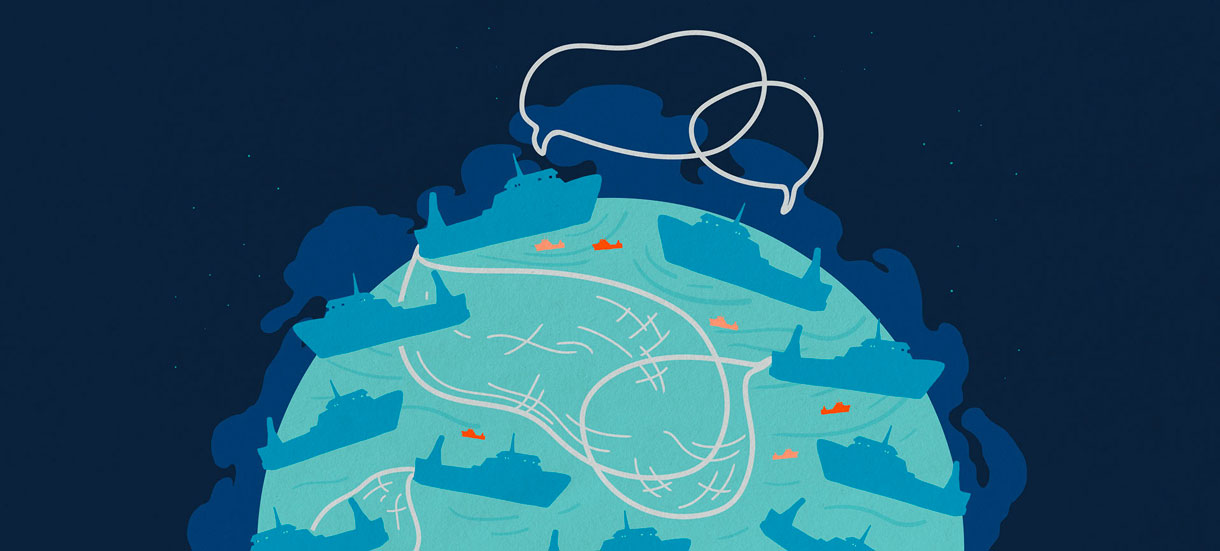
Henrik and his colleagues identified the 13 actors with the biggest influence in the fishing and aquaculture indistries. These companies have a disproportionate impact on the ocean and are called keystone actors. Illustration: E. Wikander/Azote
Keystone actors
“If you are familiar with the ecology of marine ecosystems, you probably know of the term ‘keystone species’,” Henrik says. The term was coined in the late 1960s by Robert T. Paine, “he’s a bit of a hero really. He used the term to describe species with a disproportionate effect on the structure and function of an ecosystem. Managing these species makes a big difference for the ecosystem as a whole,” he continues. “We were talking through our notes, and Carl had the idea – what if there were also ‘keystone actors’ for the ocean – actors whose influence was also disproportionally big. And what if we could find them.”
So the search started. Henrik and his colleagues, primarily Jean-Baptiste Jouffray, PhD student at the centre, spent the next few years going through documentation, making phone calls, going to meetings and networking worldwide with the biggest corporations in the fishing and aquaculture industry, and anyone who might have information about them and their activities.
“As a team we have a wide set of skills, and different networks to draw on. I don’t think doing this kind of work alone would have produced the same results, but together we could find ways to navigate through the domains of academia and industry and find a common language to really start a dialogue with the big corporations.” It was an experience that Henrik says he’s learned a lot from. “There have been a lot of challenges along the way, communication across disciplines, sectors, languages and cultures, but we’ve managed to build on each other’s expertise. In the end, I think it’s astonishing to learn how much potential there is in dialogue and collaboration.”
The Soneva dialogue
After crunching the numbers and identifying the 13 actors with the biggest influence in the fishing and aquaculture industries, Henrik and his colleagues went on to contact them.
“We figured that if we could get these companies around the table, provide them with the insights we have around the state of the oceans, listen to their perspectives and also let them share with each other – then something interesting would happen, and hopefully we could be part of pushing for sustainable practices,” Henrik says.
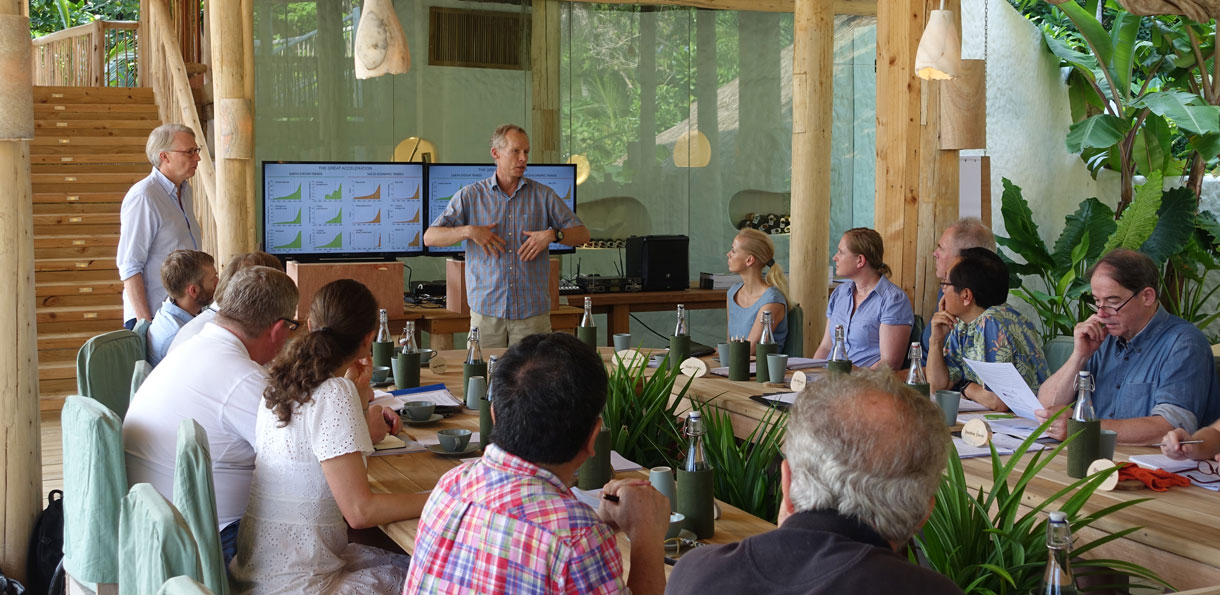
Centre science director Carl Folke and centre director Johan Rockström presenting at the Soneva dialogue. Photo: J-B. Baptiste/Stockholm Resilience Centre
In November 2016 the team of researchers invited representatives of the largest seafood corporations to take part in a dialogue in the Maldives, hosted at the Soneva resort (hence the name “the Soneva dialogue”). HRH Crown Princess Victoria of Sweden acted as patron for the dialogue, hosted by the SRC, with support from Forum for the Future and the Soneva Foundation, and funding from the Walton Family Foundation, The Gordon and Betty Moore Foundation and the David and Lucile Packard Foundation.
Centre director Johan Rockström and science director Carl Folke set the scene at the dialogue, sharing the insights from science on the global challenges ahead, and how they are relevant to industry: ocean acidification, depletion of fish stocks, loss of biodiversity, all factors that will have consequences for any business that relies on what the ocean can provide.
“This was sort of a research-based shock treatment it seemed, and it made the representatives share other challenges they face as well, related to for instance piracy or modern-day slavery,” Henrik says. “I think the knowledge sharing that took place in the dialogue sparked a new way of thinking about the role their companies’ can play moving ahead – that it’s not about managing just their fisheries or fish farms, but rather that they have a lot of influence on a global system.”
The dialogue in November resulted in a ten-point statement, signed by the eight companies who were present, committing to action on ocean stewardship, improving transparency and traceability and reducing illegal, unreported and unregulated fishing in supply chains.
SeaBOS and beyond
The keystone actor dialogue was the first of its kind, and the response from industry has been really impressive and pleasing, Henrik says. He recently accepted the Sweden Impact Award 2017 for social sciences and humanities from AESIS (Network for Advancing & Evaluating the Societal Impact of Science), and two more companies have signed the statement this year.
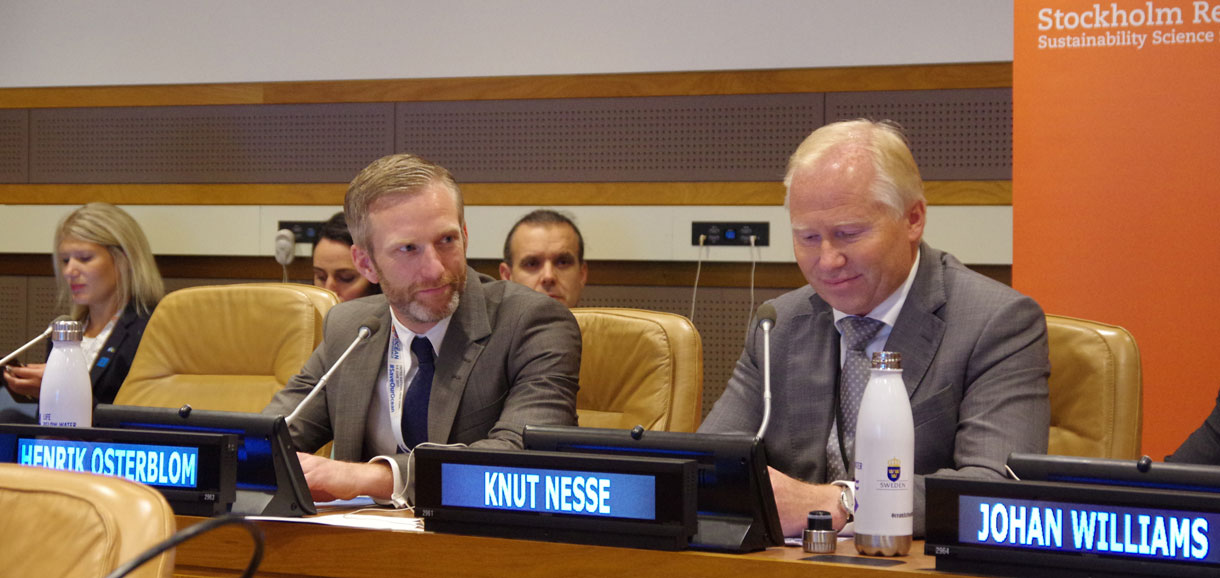
Henrik Österblom and Knut Nesse, CEO of Nutreco, a global leader in animal nutrition and aquafeed, presented the SeaBOS initiative at the UN Oceans conference in June 2017
But the work continues: A second dialogue took place in Stockholm, in May 2017. And at the UN Oceans conference that took place in New York in early June 2017, Henrik, together with Knut Nesse, CEO of Nutreco, a global leader in animal nutrition and aquafeed, presented the SeaBOS initiative. The initiative currently includes ten of the largest seafood producers in the world, committed to eliminating overfishing, modern slavery and improving fisheries and aquaculture management.
For Henrik and his colleagues, the journey may have been winding and sometimes uphill, but it seems it has paid off, and Henrik shows no sign of wanting to switch course.
“Having gotten this far, it’s really exciting to start seeing results. We have learned a lot in the process of building up to this dialogue, and I really look forward to putting it all together,” he says. “And there’s more to be done – we still have some companies to get on board, so we’ll keep working on that.”
Henriks Österblom’s research focuses on globalization and marine social-ecological systems, in particular how fisheries and marine ecosystems are managed. He is also deputy science director at the Stockholm Resilience Centre
Read more about the Soneva dialogue on the Keystone Dialogues website and on rethink.earth
